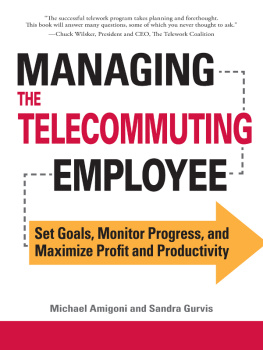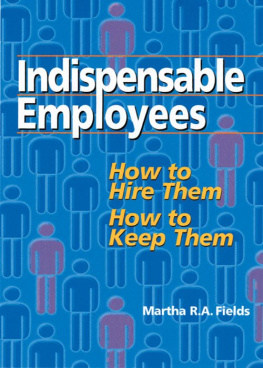

MANAGING
THE
TELECOMMUTING
EMPLOYEE
Set Goals, Monitor Progress, and
Maximize Profit and Productivity
Michael Amigoni and Sandra Gurvis

Avon, Massachusetts
Copyright 2009, Sandra Gurvis
All rights reserved.
This book, or parts thereof, may not be reproduced in any
form without permission from the publisher; exceptions are
made for brief excerpts used in published reviews.
Published by Adams Business, an imprint of
Adams Media, a division of F+W Media, Inc.
57 Littlefield Street, Avon, MA 02322. U.S.A.
www.adamsmedia.com
ISBN 10: 1-59869-887-7
ISBN 13: 978-1-59869-887-9
eISBN: 978-1-44051-335-0
Printed in the United States of America.
J I H G F E D C B A
Library of Congress Cataloging-in-Publication Data
is available from the publisher.
This publication is designed to provide accurate and authoritative information with regard to the subject matter covered. It is sold with the understanding that the publisher is not engaged in rendering legal, accounting, or other professional advice. If legal advice or other expert assistance is required, the services of a competent professional person should be sought.
From a Declaration of Principles jointly adopted
by a Committee of the American Bar Association
and a Committee of Publishers and Associations
Many of the designations used by manufacturers and sellers to distinguish their product are claimed as trademarks. Where those designations appear in this book and Adams Media was aware of a trademark claim, the designations have been printed with initial capital letters.
This book is available at quantity discounts for bulk purchases.
For information, please call 1-800-289-0963.
To our respective families and pets, who provide
diversion, comfort, and support, and keep us
grounded in the realities of working at home.
Contents
PART ONE
Telecommuting: What It Is and What It Means
Chapter 1
What Is Telecommuting?
Chapter 2
Types of Nontraditional Work Arrangements
Chapter 3
The Telecommuting Personality
Chapter 4
Types of Virtual Teams
Chapter 5
The Challenges of Virtual Teams
Chapter 6
Dealing with Diversity
PART TWO
Laws of the Jungle: Nuts and Bolts of Managing Telecommuting Employees
Chapter 7
Setting Up a Telecommuting Team
Chapter 8
Hiring
Chapter 9
Training
Chapter 10
Equipping
Chapter 11
Insurance, Benefits, and Tax Issues
Chapter 12
Managing Workers and Workload
Chapter 13
Keeping Track and in Touch
Chapter 14
Evaluating and Strengthening Performance
PART THREE
Leader of the Pack: How to Effectively Guide and Manage Your Telecommuting Team
Chapter 15
Handling Different Types of Jobs
Chapter 16
Managing Real-Time and Virtual Meetings
Chapter 17
Evaluating the Success of Your Telecommuting Program
Chapter 18
Growing Your Telecommuting Footprint
Appendix A
Sample Self-Evaluation FAQ for Telework
Appendix B
Sample Work Agreement/Contracts
Appendix C
Home Office Inspection and Safety Guidelines
Appendix D
Ergonomics Guidelines and Information
Appendix E
Glossary and Definitions
Acknowledgments
Any book is a team effort, and wed like to thank the following people for their help:
Chuck Wilsker of the Telework Coalition, who made this collaboration possible.
Susan Harrington of Harrington Software Associations for her excellent information and generous sharing of same.
Mark Goldstein, whose excellent glossary adds a dimension of understanding to those both new and familiar with telecommuting.
All the dedicated entrepreneurs at AROLester Ham, Joye Moore, RJ Johnson, Brad Frederick, and David Devoy.
For Michael: Professor Darrel Sutter whose insistence on pursuing your goals has remained for a lifetime.
For Sandra: Nancy Harding, who despite many obstacles, showed that no matter who you are, you can succeed with determination and a clear vision.
How to Use This Guide
This book is designed for anyone concerned with managing telecommuting employees. More and more managers are supervising employees who are physically distant from them, and these employees may work in a variety of settingsin an office, at home, or on the road. So, ready or not, managers are confronted with new ways of thinking and doing things.
However, such changes dont have to be painful; they can be enjoyable, interesting, and downright productive. If you are managing workers properly, theyre motivated, doing their job well, and making money for the company. Why not train employees to work from the comfort of their homes, saving money and the environment?
Hence, this book, intended to be a managers comprehensive guide to the brave new world of telecommuting. Part One covers the basicswhat telecommuting is and what it means to you and your employees. Along with defining the different kinds of telework, and delineating the advantages and disadvantages of them, the chapters explain the various types of nontraditional work arrangements and virtual teams. We also define the all-important Telecommuting Personality, characteristics of which are essential to any successful off-site effort. This section also includes the challenges of dealing with diversity, as well as employees rights, in addition to methods of designing and implementing virtual teams.
Then its on to Part Two, the nuts and bolts of managing teleworkers: how to set up a team through cost analysis, defining goals and types of jobs, and other implementation issues. Ways of overcoming managers resistance are also included, for without their cooperation and support, any workforce effort is doomed. We cover hiring, training, and equipping teleworkers; in many ways, they are different from office-based employees, requiring a much more results-oriented approach, as opposed to merely focusing on processes. Not only do you need to make sure their home office is in a safe, secure, and work-conducive environment, but they must be educated as to the importance of ergonomics, proper equipment, and ways to avoid computer viruses and data theft.
Other complexities facing managers of telecommuters include insurance, benefits, and tax issues, the fine points of which are still being debated in courts and among legislators.
Once youve got workers in place, how do you actually manage them? We offer insight on how to set clear boundaries, goals, and methods of communication; provide feedback; keep track and in touch; and perhaps most important, establish trust between and among employees and managers.
Telecommuting employees, especially those just beginning, face a number of challenges. Other chapters provide suggestions for dealing with distraction, procrastination, and lack of self-discipline. We discuss how to overcome isolation and help ease the transition into home officing. Still other chapters will help managers distinguish between normal adjustment problems and red flags indicating that the telecommuting program might not be working.
Next page









